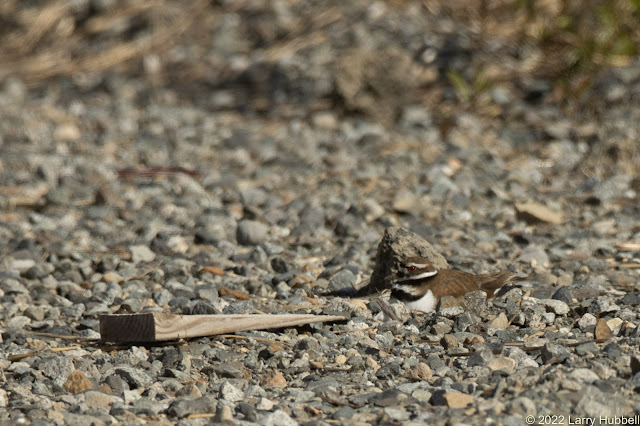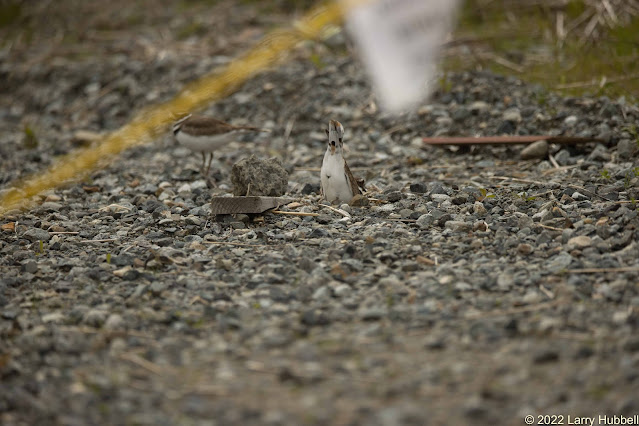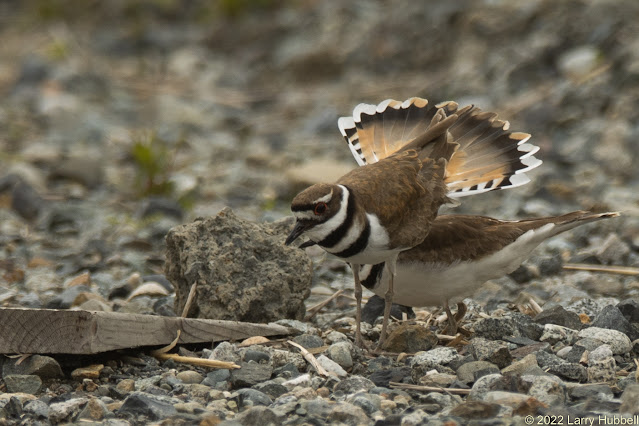A Killdeer so tiny one can easily imagine it still in the egg.
Practically, all legs and feet. It cannot fly for the first month, so fast footwork is critical to surviving.
Being quick with the bill is also helpful.
The young killdeer successfully caught an insect!
Last year, when the adult Killdeer (the mother I presume) sounded a warning the chick also knew to hide.
The young one nuzzled against the mother's breast.
It was looking for an opening.
The adult made room by slightly lifting a wing.
When she settled to the ground, the young bird was completely hidden.
Killdeer are the most common, year-round shorebird around Union Bay. They nest on the ground and, unlike any other local bird I can think of, totally out in the open. You would think this would make their nests easy to see. But it has not worked that way for me.
Until this year, I had seen photos of Killdeer nests but I had never actually seen a nest with eggs. A previous post, Precarious or Precocious, shows photos of young as they develop and also a wonderful photo of a nest with eggs - taken by Sarah Schmidt. It is obvious in the photo that Killdeer do not build a nest in the popular fashion. It seems like they simply lay their eggs on the rocks and cross their fingers (so to speak).
There are multiple challenges to seeing a Killdeer nest. The first of course is:
- Not being able to see their well-camouflaged eggs, and then
- Not wanting to disturb the birds while nesting, and
- Not wanting to draw attention to their nests. (Crows love to raid their nests.) and finally
- The fear of accidentally stepping on an unseen nest and crushing the eggs.
To protect a nest the mate, of a nesting bird, will begin screeching and often act as though it has been injured to draw you away from the nest.
This Killdeer, the male I would guess, looks over his shoulder as if to say, "Is it working?"
I suspect in the previous photo, where you primarily see the back of the head, he may be able to see you, given the extended horizontal positioning of his eyes. It is almost like having eyes in the back of his head.
This year, for at least the third year in a row, there were multiple nests inside the 520 construction area. Not only was the construction area fenced off, but inside the fence, orange tape marked a smaller area reserved for the nesting Killdeer.
I limited the length of my observations and watched carefully for crows. However, every time I was in the area I would take a brief look at the nest.
Finally, after years of looking, I spotted Killdeer eggs on the open ground.
They are in the band of the photo that is most in focus and slight right of center. If you still don't see them that is actually good. It means their camouflage works!
I suspect I saw the adult on the nest a few days before I spotted the eggs. Plus, most likely the person who spotted the nest in the construction site added the pointed piece of wood specifically to help note the location.
The only thing that would have helped more would have been flashing lights and arrows. Of course, I would not have wanted that. However, I am amazed that the Killdeer chose to nest amid earth moving equipment, cranes, cement trucks, their various back-up buzzers, and all the other noise, confusion, and activity.
A month later, they were ready to try again.
According to Birds of the World the male, typically, scrapes out a nest site with his feet. In this case, it looked like he (or she) was pushing with the feet but using their chest to physically move the rocks and dirt.
This effort went on for about five minutes before the next phase of the breeding ceremony continued.
This exact process is documented in Birds of the World. The male (typically) displays his tail, vocalizes, and moves out of the scrape as the female moves in.
The male is said to sometimes throw bits of material over his shoulder as he moves away. Plus, the whole process may be repeated many times with the roles reversing, depending on which one starts out in the nest.
All About Birds mentions that they may add a few light-colored sticks and rocks to the site after they start laying eggs.
For the most part, I will not be sad once the 520 construction is complete. However, I do fear for the Killdeer. They used to nest in Parking Lot 10 on the west side of the Union Bay Natural Area (UBNA). However, as part of the 520 mitigation, that parking lot was planted and turned into a wonderful marsh area. Much of the other open area in UBNA was also densely planted, with native plants, and of course, the construction area will ultimately be paved or planted.
Down the road, I am just not sure where the Killdeer will find open ground for nesting near Union Bay. We can only hope their flexibility, in using an active construction site, indicates they will make creative compromises in the future.
****************
Click Here to see an animated migration of North American Killdeer via the Cornell Lab's weekly abundance map.
****************
In other news, Friends of Arboretum Creek (FOAC), has successfully completed the 30% Design phase of the Headwaters Project. This project will add clean water to Arboretum Creek, enhancing the ecosystem, and protect the Japanese Garden from flooding.
Select one of the following to learn more:
The FOAC website:
The 30% Design Report and Plans:
Current Activities:
****************
****************
Have a great day on Union Bay...where nature lives in the city!
Larry
Recommended Citation
Jackson, B. J. and J. A. Jackson (2020). Killdeer (Charadrius vociferus), version 1.0. In Birds of the World (A. F. Poole and F. B. Gill, Editors). Cornell Lab of Ornithology, Ithaca, NY, USA. https://doi.org/10.2173/bow.killde.01Going Native:
Each of us, who breathe the air and drink the local water, needs to watch and protect our local environment. Native plants and trees encourage the largest diversity of lifeforms because of their long intertwined history with our local environment and native creatures. Even the microbes in the soil are native to each local landscape.
I hope we can inspire ourselves, our neighbors, and local businesses to respect native flora and support native wildlife at every opportunity. I have learned that our most logical approach to native trees and plants (in order of priority) should be to:
1) Learn and leave established native flora undisturbed.2) Remove invasive species and then wait to see if native plants begin to grow without assistance. (When native plants start on their own, then these plants or trees are likely the most appropriate flora for the habitat.)3) Scatter seeds from nearby native plants in a similar habitat.4) If you feel you must add a new plant then select a native plant while considering how the plant fits with the specific habitat and understanding the plant's logical place in the normal succession of native plants.
***************
My friend Elaine Chuang shared several resources (that were new to me) from the January 2022 Washington Ornithological Society meeting. By the way, Elaine credits Vicki King for researching and supplying this information. The major new concept is that specific keystone native plants enable critical moths and caterpillars that in turn provide food for the great majority of birds, especially during the breeding season. Here are the top two links from her list.
Native Keystone Plants for Wildlife:
https://www.youtube.com/watch?v=O5cXccWx030
Resources for adding plants to your Pacific Northwest Garden:
https://wos.org/wos-wp/wp-content/uploads/2021/12/native-plant-resources-v2.pdf
***************
In the area below it is my intention to display at least one photo each week to help challenge us to know the difference between native and non-native lifeforms.
Scroll down for the answer.
******************
Pacific Ninebark: Yes. It is native to the PNW. Click on the name to learn more.
*****************
The Email Challenge:
In response, I have set up my own email list. With each post, I will manually send out an announcement. If you would like to be added to my personal email list please send me an email requesting to be added. Something like:
Larry, I want to see more of nature. Please add me to your personal email list.
Thank you for your patience and interest!
Another common issue is losing your input while attempting to leave a comment on this blog. Often everything functions fine, however, sometimes people are unable to make it past the robot-detection challenge or maybe it is the lack of a Google account. I am uncertain about the precise issue. Sadly, a person can lose their comment with no recovery recourse.
My email address is:
LDHubbell@comcast.net
*******************
The Comment Challenge:
Bottom Line:
If you write a long comment, please, copy it before hitting enter. Then, if the comment function fails to record your information, you can send the comment directly to me using email.
My email address is:
LDHubbell@comcast.net
Sincerely,
Larry
Final Photos:



































Hey Larry, love this post.
ReplyDelete-James
James, Thank you! Nice to meet you yesterday. I hope you find a way to join all of us out here in the wilds of the Pacific Northwest. Larry
Delete